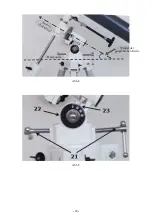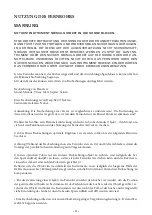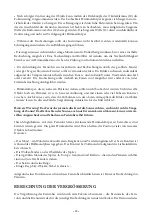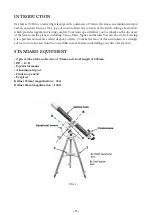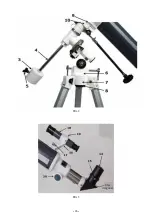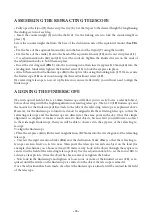
• 32 •
USING THE REFRACTING TELESCOPE
WARNING
NEVER USE AN INSTRUMENT TO LOOK DIRECTLY AT THE SUN.
LOOKING DIRECTLY AT THE SUN, OR IN ITS IMMEDIATE SURROUNDING AREA,
WILL CAUSE IMMEDIATE AND IRREVERSIBLE DAMAGE TO YOUR SIGHT. SIGHT
DAMAGE DOES NOT GENERALLY CAUSE ANY PAIN, AND THE OBSERVER WILL HAVE
NO WARNING UNTIL IT IS TOO LATE. NEVER POINT THE INSTRUMENT, OR THE
FINDERSCOPE, DIRECTLY AT OR IN THE SURROUNDING AREA OF THE SUN. DO
NOT LOOK IN THE EYEPIECE OR THE FINDERSCOPE WHEN THE INSTRUMENT IS
MOVING. ANY USE BY CHILDREN MUST BE SUPERVISED BY AN ADULT.
Once the refracting telescope has been set up, the finderscope set and the poles aligned, you are ready
to start your observations.
Your refracting telescope will allow you to carry out two types of observations:
Planetary observations:
The Moon, Mercury, Venus, Mars, Jupiter, Saturn.
Starting your observations of the deep sky:
With several Galaxies, Nebulae...
Note: it will not be of any particular interest to observe a star. Essentially, stars are so far away that
when seen through a refracting telescope, they look like a simple dot!
For your first observation, choose something easy to see: The Moon to help you get used to how the
refracting telescope works and how to use it.
To achieve the best results during your observations, heed the following advice:
Warning: During all observations, your refracting telescope must remain aligned, so you can benefit
from the advantages of the equatorial mount.
In order to move the optical tube towards an object to be observed, you simply need to unscrew the
two brakes (RA) and (Dec) so that the telescope can turn freely, while the right ascension axis conti-
nues to point to the North star.
Once an object becomes visible in the instrument’s field of view, you will simply need to slowly turn
the right ascension knob (12) to offset the rotation of the Earth throughout the observation.
• To centre an object in the refracting telescope, first use the finderscope to locate the object that you
wish to observe. Once the object is centred in the reticle of the finderscope, it will appear in the eyepie-
ce of the instrument. (If this is not the case, it means that the finderscope is not set: see how to adjust
the finderscope) tighten the two brakes (RA) and (Dec).
• Always start an observation with a low-powered eyepiece (for example, eyepiece K 25mm)
• Once the object has been centred, you can align the poles by turning the buttons on the eyepiece
holder (20). You will note that the celestial body observed starts to slowly move within the field of the
Summary of Contents for Mizar 70/900
Page 4: ... 4 FIG 2 FIG 3 ...
Page 5: ... 5 FIG 4 FIG 5 ...
Page 9: ... 9 FIG 8 FIG 9 ...
Page 15: ... 15 Abb 2 Abb 3 Zenitspiegel ...
Page 16: ... 16 Abb 4 Abb 5 Koordinatenringe D RA ...
Page 20: ... 20 Abb 8 Abb 9 Norden Polarstern Horizontal Winkel der geografischen Breite ...
Page 26: ... 26 FIG 2 FIG 3 Star diagonal ...
Page 27: ... 27 FIG 4 FIG 5 Setting circles Dec RA ...
Page 31: ... 31 FIG 8 FIG 9 Angle of latitude North polar star ...



